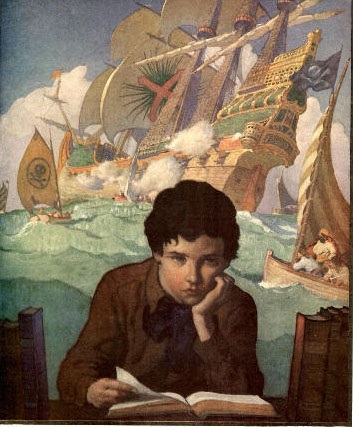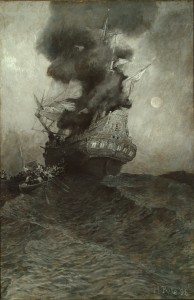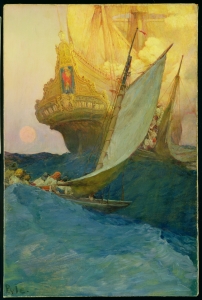
N. C. Wyeth (1882-1945)|Imagination, c. 1921|Cover illustration for Ladies' Home Journal (March 1922)|Oil on canvas|Private collection, MA
Inside books are worlds to be found, battles to be fought, discoveries to be made, and life paths to be chosen. The joining of a wonderful story and a receptive mind provides possibilities untold. So, for those of us who love to read, one of the true rewards may be found in the illustrations that accompany or decorate the stories we love.
During the America’s golden age of illustration (1880-1930) many wonderful illustrations were used on the covers of books and magazines, inside children’s story books, and even as frontispiece images for the more adult book publications. The illustrations that picture stories not only provide a stepping stone for the reader into the imagery of the story, but they can also help us to transform the written word into a visual construct. N. C. Wyeth’s painting, Imagination, is the concept made manifest of how we internalize and visualize what we read.
As the boy reads from the book on the table in front of him, he is surrounded by books at either side. While turning the page of the book he’s reading, he looks up into space and the image that fills his mind becomes observable in the space behind his head. It is a galleon on the high seas being attacked by pirates in smaller sail boats. Wyeth cleverly focused our attention on the galleon by surrounding its form with white billowing clouds that help to pop that portion of the image forward.
The cloud-like puffs of smoke at the galleon’s starboard side mark the detonation of the cannons that line the sides of the ship’s gun deck. A galleon was purposely built as a war-ship, and so the starboard and port cannon windows were a standard feature of this type of vessel. Counting the various ship masts we can see that this is a five-mast galleon. By showing a pirate flag flying from the mast of the small boats or decorating the sail with a skull and cross bones, without writing a word, Wyeth clearly indicated that the galleon was being attacked by pirates.
Around the turn-of-the-century stories about and images of pirates were prevalent in the popular press. This was in part due to the raft of work produced by Wyeth’s teacher, the illustrator Howard Pyle (1853-1911). By my count Pyle created over 60 illustrations and images of pirates over his career. For example, Pyle’s Burning Ship, from 1898 was reproduced as a full page illustration in Collier’s Weekly December 10, 1904 issue.

Howard Pyle (1853-1911)|The Burning Ship, 1898|Oil on canvas|Delaware Art Museum, Museum purchase, 1912-4

Howard Pyle (1853-1911)|An Attack on a Galleon, 1905|Illustration for "The Fate of a Treasure Town" by Howard Pyle in Harper's Monthly Magazine (December 1905)|Oil on canvas|Delaware Art Museum, Museum Purchase, 1912-32
While Wyeth was a student in Pyle’s Wilmington, Delaware school, “The Fate of a Treasure Town” was written and illustrated by Pyle. When the publication came out, those images were “the sensation of the magazine world” according to Pyle’s biographer Charles C. Abbott. The dramatic composition An Attack on a Galleon was full of rich color and must have served as an inspiration for Wyeth’s Imagination.
N. C. Wyeth layered his illustration with a clue that that wonderful image of the pirates attacking the galleon comes from the boy’s artistically fired imagination. The boy pictured wears a brown shirt with a large floppy black bow tied at the neck. That floppy tie was typically worn by creative types, poets, artists and architects, in the early decades of the 20th century.
One of those creative types, Robert Louis Stevenson (1850-1894), wrote the poem, “The Land of Story-books” in his book A Child’s Garden of Verse (1885). I’ve excerpted a portion of that poem as the fitting ending for this piece:
At evening, when the lamp is lit,
Around the fire my parents sit;
They sit at home and talk and sing,
And do not play at anything.
Now, with my little gun, I crawl
All in the dark along the wall,
And follow round the forest track
Away behind the sofa back.
. . .
So, when my nurse come in for me,
Home I return across the sea,
And go to bed with backward looks
At my dear land of Story-books.
Happy reading!
December 10, 2009
By Joyce K. Schiller, Curator, Rockwell Center for American Visual Studies
Norman Rockwell Museum






